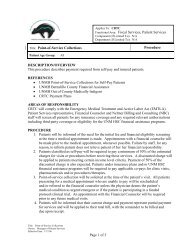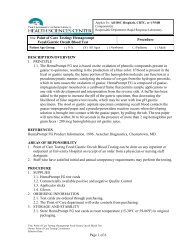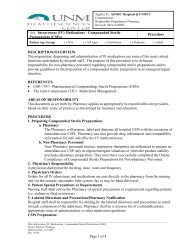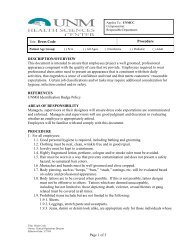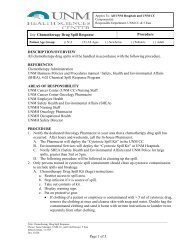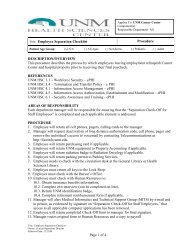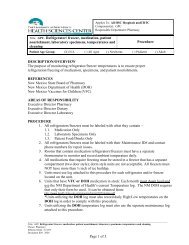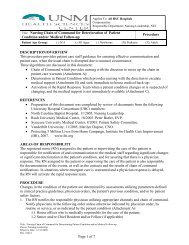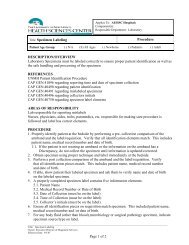Page 1 of 25 DESCRIPTION/OVERVIEW The purpose of this ...
Page 1 of 25 DESCRIPTION/OVERVIEW The purpose of this ...
Page 1 of 25 DESCRIPTION/OVERVIEW The purpose of this ...
You also want an ePaper? Increase the reach of your titles
YUMPU automatically turns print PDFs into web optimized ePapers that Google loves.
decision are the patient, the patient's family, the physician, and the nurse<br />
assigned to the Vascular Access Resource Team (VART). Appropriateness <strong>of</strong><br />
the candidate, the prescribed therapy, expected outcomes, as well as the<br />
potential benefits and risks will be determined.<br />
1.6. <strong>The</strong> PICC team member evaluates the patient for the placement <strong>of</strong> the PICC at<br />
the bedside.<br />
1.7. If the PICC team member determines that a PICC cannot be placed at the<br />
bedside, a physician’s order is required for placement <strong>of</strong> the PICC in<br />
Interventional Radiology.<br />
1.8. A request is sent to Interventional Radiation (IR) for placement <strong>of</strong> the PICC.<br />
Scheduling proceeds from the IR.<br />
2. Qualifications for selection <strong>of</strong> a VART candidate:<br />
2.1. Selection Criteria:<br />
2.1.1. Registered nurse with current New Mexico licensure<br />
2.1.2. IV module completed.<br />
2.1.3. Recommended by Unit Director.<br />
2.1.4. Successful completion <strong>of</strong> Long Arm Catheter (LAC) training process<br />
as verified by the University Hospital Education Department<br />
2.1.4.1. Completion <strong>of</strong> competency checklist and receipt <strong>of</strong> form by<br />
the Education Department. A certificate <strong>of</strong> completion is<br />
awarded to the individual.<br />
2.1.4.2. Successful placement <strong>of</strong> five long arm catheters in the<br />
presence <strong>of</strong> a preceptor during training.<br />
2.2. Maintaining Qualification:<br />
2.2.1. Successful placement <strong>of</strong> 10 LAC per year.<br />
2.2.2. Participate in annual VART update<br />
2.2.3. Development <strong>of</strong> unit in-services and updates.<br />
2.2.4. Participation in the Performance Improvement Patient Safety<br />
Committee<br />
3. Long Arm Catheter Insertion Procedure- Attachment A<br />
4. Long Arm Catheter Removal Procedure- Attachment B<br />
5. Long Arm Catheter Length Selection Guidelines- Attachment C<br />
6. Care Of Pediatric Central Catheters- Attachment D<br />
7. Venous Access Port Addendum- Attachment E<br />
8. Care Of Adult Central Catheters- Attachment F<br />
9. Quick Reference Guide For Venous Access Devices- Attachment G<br />
10. Care <strong>of</strong> the VAD in the Post Anesthesia Care Unit- Attachment H<br />
11. Evaluation<br />
11.1. After VAD inserted, chest xray required for line placement. This is to be done<br />
wherever the patient had the catheter inserted. Adult midline PICCs do not require an<br />
xray prior to use. If PICC inserted in the IR, it is in the correct position and is okay to<br />
use, no xray is required. A physician’s written order is required for permission to<br />
infuse fluids.<br />
11.2. After xray evaluated by physician or radiologist, a written order is required for<br />
administration <strong>of</strong> fluids into <strong>this</strong> line.<br />
11.3. Ensure the dressing over the catheter is secure.<br />
_________________________________________________________________________________________________________________<br />
Title: Venous Access Device<br />
Owner: Clinical Education Department<br />
Effective Date: 07/27/05<br />
<strong>Page</strong> 2 <strong>of</strong> <strong>25</strong>



